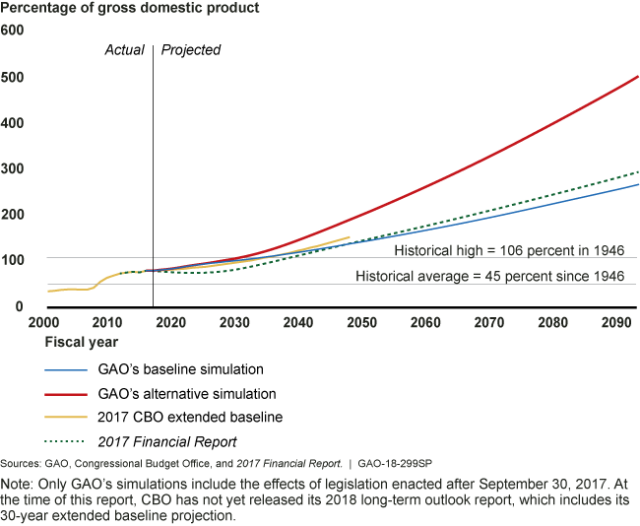The Nation’s Precarious Fiscal Future
The United States faces a highly challenging fiscal future. Absent change in policy, the federal fiscal path is unsustainable—debt is growing faster than the economy (GDP). This springs from the continuing gap between the amount of money the federal government collects in revenue, and the amount it spends—i.e., the federal deficit.
Today we issued an update on the fiscal condition of the U.S. government as of the end of FY 2017—and its likely fiscal future if policies don’t change.
The WatchBlog explores the nation's fiscal health. Listen to our podcast with Susan Irving, our expert on debt and fiscal issues, then read on for more.
Staying in the red
The 2017 Financial Report, CBO, and GAO projections all show that, without policy changes, debt will continue to grow faster than the economy.
Debt held by the public—money the government has borrowed by selling Treasury bills, notes, and bonds—was 76% of the gross domestic product (the economy) at the end of fiscal year 2017. If nothing changes, that ratio will surpass its historical high of 106% within 14 to 22 years.
The challenge facing policymakers is not any single year’s deficit increase—it’s the outlook for future years. Health care costs, Social Security, and interest on the debt are all driving spending growth going forward.
Under our simulation, absent any policy changes, interest becomes the largest single claim on the federal budget—exceeding 25% of all spending in 2059.
Tough choices
The timeline below shows that key Medicare and Social Security trust funds are projected to face major financial challenges.
It’s clear that the federal government is going to have to make some tough choices in the near future. It is important to develop and begin to implement a long-term fiscal plan for returning to a sustainable path. The longer action is delayed, the greater and more drastic the changes will have to be.
Call to action
While changes to Social Security, health care, and interest require legislative actions to alter fiscal policies, federal agencies can still play a role in improving the nation’s fiscal health. Over the years, we’ve identified a number of things federal agencies can do, such as:
- Reducing improper payments. Improper payments (payments that shouldn’t have been made or were made in the incorrect amount) are estimated to have cost the government about $141 billion in fiscal year 2017. Agencies need to identify the root causes of these payments and then implement internal controls aimed at both prevention and detection.
- Reducing the tax gap (taxes owed vs. taxes paid). The annual net tax gap was most recently estimated to be $406 billion. This will require action on multiple fronts such as using tax gap and other data to develop a strategy to address noncompliance and providing better customer services (by phone, mail, and online) to help with tax prep.
These kinds of actions will help—both with responsible stewardship of taxpayer funds and with the nation’s financial condition. However, federal agencies alone cannot put the nation on a sustainable fiscal path.
Check out our February 2018 video explaining the nation’s financial condition and future, and ways to improve it.
Visit our website to learn more about America’s fiscal future.
- Comments on GAO’s WatchBlog? Contact blog@gao.gov.
GAO Contacts
Related Products

GAO's mission is to provide Congress with fact-based, nonpartisan information that can help improve federal government performance and ensure accountability for the benefit of the American people. GAO launched its WatchBlog in January, 2014, as part of its continuing effort to reach its audiences—Congress and the American people—where they are currently looking for information.
The blog format allows GAO to provide a little more context about its work than it can offer on its other social media platforms. Posts will tie GAO work to current events and the news; show how GAO’s work is affecting agencies or legislation; highlight reports, testimonies, and issue areas where GAO does work; and provide information about GAO itself, among other things.
Please send any feedback on GAO's WatchBlog to blog@gao.gov.







